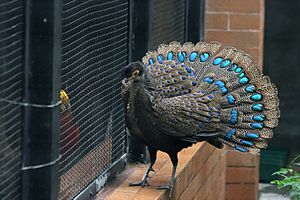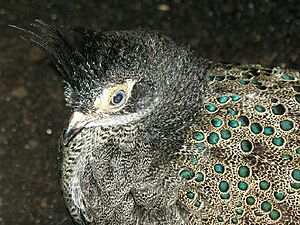Malayan peacock-pheasant facts for kids
Quick facts for kids Malayan peacock-pheasant |
|
|---|---|
 |
|
| Adult male displaying(Hong Kong Zoological and Botanical Gardens) | |
| Conservation status | |
| Scientific classification | |
| Genus: |
Polyplectron
|
| Species: |
malacense
|
| Synonyms | |
|
Pavo malacensis Scopoli, 1786 |
|
The Malayan peacock-pheasant (Polyplectron malacense) is a beautiful bird. It is also known as the crested peacock-pheasant or Malaysian peacock-pheasant. This medium-sized bird belongs to the pheasant family, called Phasianidae. It is closely related to the Bornean peacock-pheasant.
Contents
What Does the Malayan Peacock-Pheasant Look Like?
This bird has one of the shortest tails among all peacock-pheasants. Adult males are about 50 centimeters (20 inches) long. About half of this length is their tail. They weigh around 600 to 700 grams (1.3 to 1.5 pounds).
Female Malayan peacock-pheasants are a bit smaller than males. They have a shorter tail, measuring about 40 centimeters (16 inches) in total. Females weigh about 450 to 550 grams (1 to 1.2 pounds).
Feather Colors and Patterns
Their feathers are mostly pale brown. They have small black spots and bands all over their body. This creates a "salt-and-pepper" look. This pattern is common in most peacock-pheasants.
Males have shiny blue-green eyespots. These spots have a light brown border. You can see them on their upper wings, back, and tail feathers. They also have a white throat that goes down to their chest. A loose, pointed, dark blue-green crest sits on their forehead. The skin around their eyes is bare and usually pink. It turns bright orange-red when they are trying to attract a mate. Their beak and legs are blackish.
Female birds have duller colors than males. Their crest is very small. They only have eyespots on their wing and tail feathers. On their back and wing covers, they have dark dots instead of eyespots. These dots point towards the tip of the feather.
Young birds look like females. However, their eyespots are even less developed. They usually only have them on their tail feathers. Baby birds are pale chestnut-brown on top and light brown underneath.
Where Does the Malayan Peacock-Pheasant Live?
This shy bird lives in the lowland forests of the Malay Peninsula. This area stretches from the Isthmus of Kra southwards. It used to be found in many parts of Malaysia and Thailand. It was also reported in southern Myanmar, Sumatra, and Singapore. However, it has disappeared from most of these places.
Today, most of these birds live in the lowlands of central Malaysia. They might also be found slightly into Thailand. These birds usually stay in one area. They do not travel far from where they hatched. They are somewhat territorial. This means they have their own space. However, the areas of several birds might overlap. Males move around in an area of about 10 to 60 hectares. Females use an area half that size.
What Do They Eat?
The Malayan peacock-pheasant mainly lives in rainforests. These forests are usually below 150 meters (490 feet) above sea level. They rarely live as high as 300 meters (980 feet). They can live in forests that have been regrown, but they prefer old, untouched forests.
Scientists have not studied their eating habits much. But like their relatives, they probably eat a mix of plants and small arthropods. They use their feet and beak to dig for insects in the leaves on the forest floor. They have been seen eating insects like flies, grasshoppers, and ants. They also eat mollusks and isopods. Their diet includes fruits and seeds from various trees. Sometimes, they might accidentally eat things like moss or small twigs.
Reproduction and Life Cycle
The exact mating season for these birds is not fully known. Nests have been found in March, April, and August. This suggests they might breed all year round. Breeding might depend on when there is plenty of food available.
Males clear small areas in the forest. These are their display sites. From these spots, they call to their mates and young. They perform special dances and show off their feathers. These displays reveal the bright eyespots on their wings and tail. They also use these behaviors to defend themselves. Males can make clicking and vibrating sounds with their feathers.
The nest is simple. It is made of twigs and large leaves. They scrape these together on firm ground. This can be on a termite mound or directly on the forest floor. The Malayan peacock-pheasant is one of the few pheasants known to lay only one egg at a time. The egg probably takes about 22 to 23 days to hatch. These birds are often bred in zoos.
Protecting the Malayan Peacock-Pheasant
The Malayan peacock-pheasant is considered an endangered species. This is because their forest homes are disappearing. Their population is also small and their range is limited. Their numbers have dropped by about two-thirds in the last ten years. This trend is expected to continue. They are also listed on CITES Appendix II. This means their trade is controlled to prevent them from becoming more endangered.
Cutting down forests is the biggest threat to this bird. More than half of the places where they lived in the 1970s are now unsuitable for them. The amount of available forest has shrunk by over three-quarters. In 2008, there were only about 8,000 adult birds left. Hunting used to be a threat, but it is not as big a problem as deforestation today.
These birds can handle a small amount of selective logging. However, they need enough untouched primary forest to survive. Most Malayan peacock-pheasants now live in protected areas in Malaysia. These include Taman Negara National Park and Krau Wildlife Reserve. They might also be found in other reserves like Sungkai Sambar Deer and Pheasant Wildlife Reserve and Sungai Dusun Wildlife Reserve.
In areas where they are protected and have good habitat, they can be quite common. This makes them a "flagship species." They can help promote ecotourism and other ways to use the forest without harming it. There is also a population of these birds in zoos. In 1993, there were 189 birds in 35 zoos. The Department of Wildlife and National Parks of Malaysia is planning a program to breed these birds in captivity. This will help increase their numbers in reserves and keep their genes healthy.
Images for kids
-
Adult male's mantle feathers with their eyespots and "salt-and-pepper" pattern




